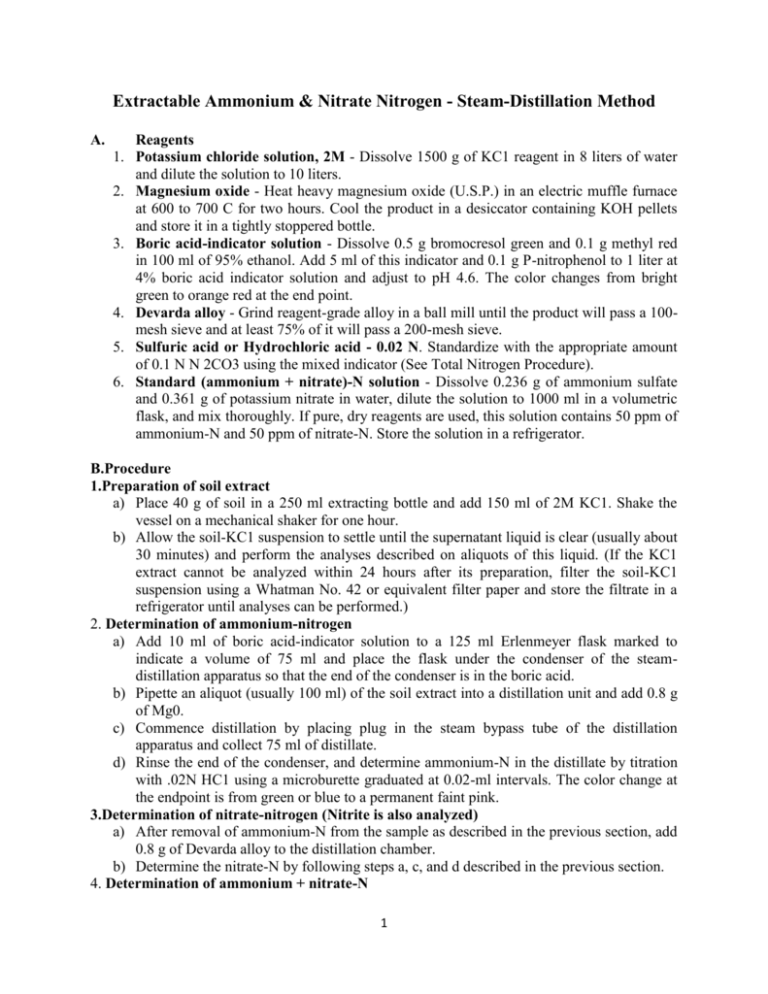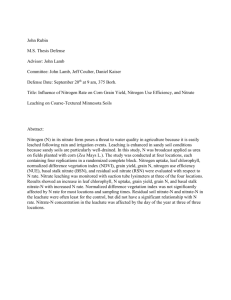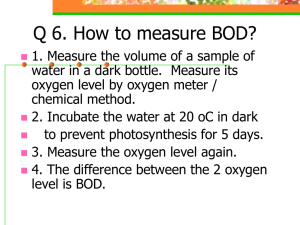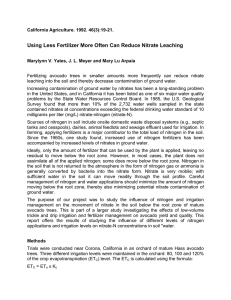Extract. Ammonium & Nitrate N
advertisement

Extractable Ammonium & Nitrate Nitrogen - Steam-Distillation Method A. 1. 2. 3. 4. 5. 6. Reagents Potassium chloride solution, 2M - Dissolve 1500 g of KC1 reagent in 8 liters of water and dilute the solution to 10 liters. Magnesium oxide - Heat heavy magnesium oxide (U.S.P.) in an electric muffle furnace at 600 to 700 C for two hours. Cool the product in a desiccator containing KOH pellets and store it in a tightly stoppered bottle. Boric acid-indicator solution - Dissolve 0.5 g bromocresol green and 0.1 g methyl red in 100 ml of 95% ethanol. Add 5 ml of this indicator and 0.1 g P-nitrophenol to 1 liter at 4% boric acid indicator solution and adjust to pH 4.6. The color changes from bright green to orange red at the end point. Devarda alloy - Grind reagent-grade alloy in a ball mill until the product will pass a 100mesh sieve and at least 75% of it will pass a 200-mesh sieve. Sulfuric acid or Hydrochloric acid - 0.02 N. Standardize with the appropriate amount of 0.1 N N 2CO3 using the mixed indicator (See Total Nitrogen Procedure). Standard (ammonium + nitrate)-N solution - Dissolve 0.236 g of ammonium sulfate and 0.361 g of potassium nitrate in water, dilute the solution to 1000 ml in a volumetric flask, and mix thoroughly. If pure, dry reagents are used, this solution contains 50 ppm of ammonium-N and 50 ppm of nitrate-N. Store the solution in a refrigerator. B.Procedure 1.Preparation of soil extract a) Place 40 g of soil in a 250 ml extracting bottle and add 150 ml of 2M KC1. Shake the vessel on a mechanical shaker for one hour. b) Allow the soil-KC1 suspension to settle until the supernatant liquid is clear (usually about 30 minutes) and perform the analyses described on aliquots of this liquid. (If the KC1 extract cannot be analyzed within 24 hours after its preparation, filter the soil-KC1 suspension using a Whatman No. 42 or equivalent filter paper and store the filtrate in a refrigerator until analyses can be performed.) 2. Determination of ammonium-nitrogen a) Add 10 ml of boric acid-indicator solution to a 125 ml Erlenmeyer flask marked to indicate a volume of 75 ml and place the flask under the condenser of the steamdistillation apparatus so that the end of the condenser is in the boric acid. b) Pipette an aliquot (usually 100 ml) of the soil extract into a distillation unit and add 0.8 g of Mg0. c) Commence distillation by placing plug in the steam bypass tube of the distillation apparatus and collect 75 ml of distillate. d) Rinse the end of the condenser, and determine ammonium-N in the distillate by titration with .02N HC1 using a microburette graduated at 0.02-ml intervals. The color change at the endpoint is from green or blue to a permanent faint pink. 3.Determination of nitrate-nitrogen (Nitrite is also analyzed) a) After removal of ammonium-N from the sample as described in the previous section, add 0.8 g of Devarda alloy to the distillation chamber. b) Determine the nitrate-N by following steps a, c, and d described in the previous section. 4. Determination of ammonium + nitrate-N 1 a) Follow the procedure described for determination of ammonium-N, but add 0.8 g of Devarda alloy to the distillation chamber immediately after addition of MgO. 5. Control and check analyses a) Controls should be performed in each series of analyses to allow for ammonium-N derived from the reagents used. b) Check the steam-distillation procedure at intervals by analyzing 5-ml aliquots of the standard (ammonium + nitrate-N) solutions. (This solution is stable for several months if stored in a refrigerator.) 6. Washing of equipment a) The distillation unit should be washed periodically with a 1:1 HC1 and then flushed with water to remove any Devarda alloy which may accumulate. The presence of Devarda alloy will cause a negative error in the nitrate-N determination. C. Calculation Calculate the analytical result from the volume of titrant as follows: ppm of ammonium or nitrate-N in the soil sample = (Sample - blank titration in mls) x N of HC1 x 14,000 pg N/meq/(Weight of soil sample represented by aliquot) D. Comments The method of Bremner (5) for determining ammonium and nitrate-N is used without modification except that 150 ml of KC1 is used instead of 100 ml. The standard equipment used for steam distillation is comparable to the set-up of Bremner and Edwards (4). Nitrate-N may be extracted from soil with a short 5 to 10-minute period of shaking with water or dilute, N-free salt solution (5). If there is no interest in determining sulfur (5) in addition to nitrate in the aqueous soil extract, a saturated calcium sulfate solution may serve as extractant. A dilute aqueous solution prepared from one of a number of chloride salts may be suitable for extracting both nitrate and sulfate (5, 19). Some improvement in the analytical precision is obtained for determining nitrate in the range of 1 to 5 ppm by using a 1 to 2.5 ratio of soil sample to extractant, which is a modification of the standard procedure. The extended period of shaking the soil sample with 2N KC1 according to the specifications of Bremner's original procedure permits the extraction of exchangeable ammonium in addition to nitrate. The Mg0 reagent used for distillation should be ignited for removal of carbonate. The purified product should be stored in an airtight container to protect it from the atmospheric CO 2. The liberation of CO from the MgO may interfere with the determination of ammonia by the titration method (5). 2






